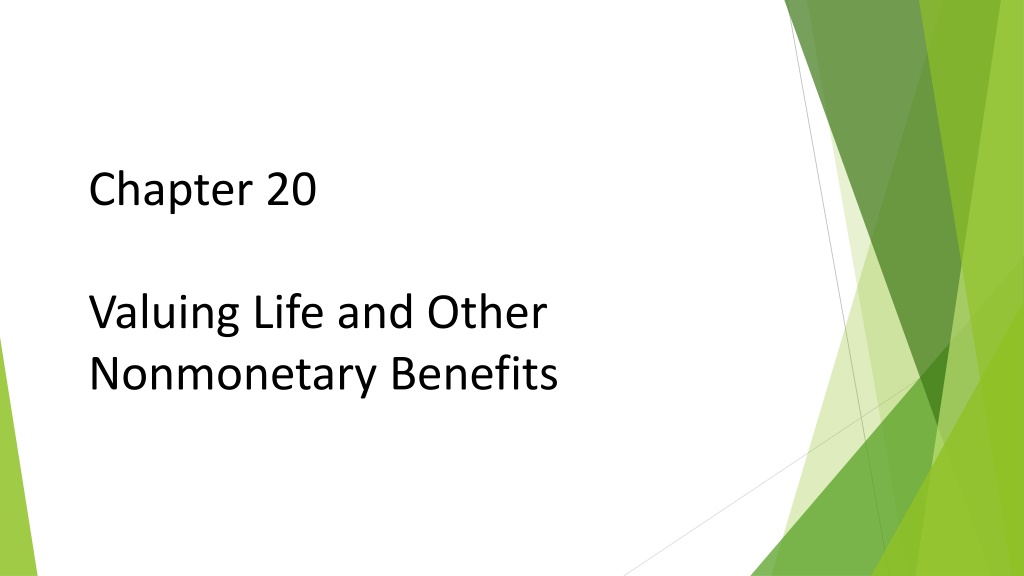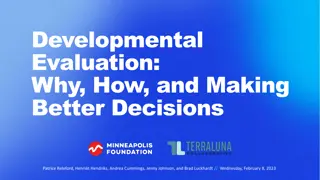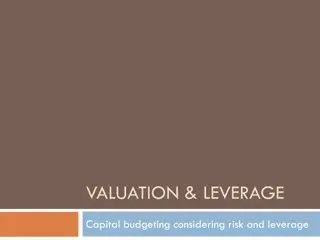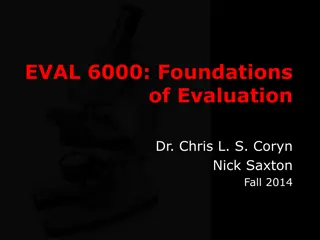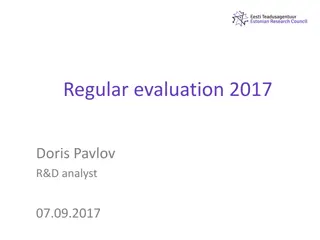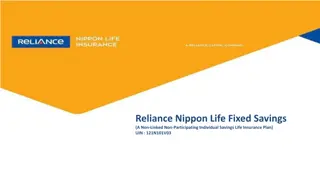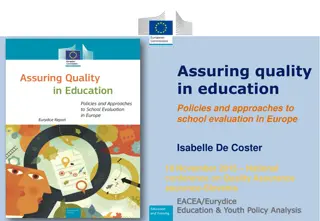Valuing Life and Nonmonetary Benefits: Approaches and Policy Evaluation
This chapter discusses the importance of valuing life and other nonmonetary benefits in the context of social regulation. It covers approaches used to determine the degree of social regulation needed, such as estimating implicit prices for social risk commodities and interviewing individuals on the value of health outcomes. Policy evaluation principles, willingness-to-pay questions, and alternative approaches to valuing life are also explored, with a focus on human capital measures. The evolving perception of valuing risks to life and the necessity of tradeoffs in achieving a safer society are highlighted.
Download Presentation

Please find below an Image/Link to download the presentation.
The content on the website is provided AS IS for your information and personal use only. It may not be sold, licensed, or shared on other websites without obtaining consent from the author. Download presentation by click this link. If you encounter any issues during the download, it is possible that the publisher has removed the file from their server.
E N D
Presentation Transcript
Chapter 20 Valuing Life and Other Nonmonetary Benefits
Establishing the appropriate degree of social regulation requires that a price is set for what the regulation produces The Occupational Safety and Health Administration (OSHA) and the Environmental Protection Agency (EPA) There are two approaches used to gain a better sense of the degree to which various forms of social regulation should be pursued 1) Estimate the implicit prices for social risk commodities that may be traded implicitly in markets 2) Ask people in interviews how much they value a particular health outcome
Policy Evaluation Principles Consider a scenario in which you are asked how much you would be willing to pay in cash to eliminate the risk of getting hit and killed by a bus while crossing the street when your chances are one in 10,000 This is considered a willingness-to-pay question Willingness to pay Size of risk reduction Value of a statistical life = Placing an infinite versus a finite value on risks to your life Consider the three reasons why college students often give low responses to risk reduction questions
Willingness-to-Pay versus Other Approaches Alternative approaches to valuing life have been suggested; these approaches mostly rely on various human capital measures related to one s lifetime earnings The first human capital measure one can consider is the present value of one s lifetime earnings, but this has its drawbacks A variant approach is to take the present value of lifetime earnings net of the consumption of the deceased (commonly used in court cases for compensating survivors in wrongful death cases) A final approach is to look at the taxes that people might pay; much of the appeal of this method is that it lends itself to calculation
A major policy event that led to a shift in the approach taken was the OSHA hazard communication regulation that was the subject of intense debate in the early 1980s The U.S. Office of Management and Budget (OMB) Three decades ago, raising the issue of valuing risks to life appeared to be intrinsically immoral, but it has become less controversial over the years The idea that it is not feasible to achieve an absolutely risk-free existence and that some tradeoffs must ultimately be made is becoming more widely understood
Variations in the Value of a Statistical Life There is no right answer in terms of valuing risks to life; rather, the effort is simply one to establish an individual s risk-dollar tradeoff A major source of differences in preferences is likely to be individuals lifetime wealth There is likely to be substantial heterogeneity in individual preferences, and this heterogeneity will be exhibited in the choices that people make Consider the estimates by Joni Hersch and W. Kip Viscusi Should we provide individuals with less stringent government regulations to protect them if they have revealed by other activities that they are willing to bear a variety of risks to their well-being?
The one instance in which the differences in the value of a statistical life should clearly be utilized is when assessing future impacts of regulatory programs Present value of benefit = ? 1+?? 1+?? ? 1 + ? ??
Labor Market Model Most empirical estimates of the value of a statistical life have been based on labor market data Estimate the wage-risk tradeoff that workers implicitly make as part of their jobs and use the implications of this tradeoff as an estimate of the value of a statistical life How one interprets differences in the estimated value of a statistical life depends on people s opportunities, not just their preferences Disadvantaged workers often do not have access to the same kinds of jobs as advantaged workers A statistical approach generally involves the use of a large set of data on individual employment behavior
Empirical Estimates of the Value of a Statistical Life The general form of the estimation depends in part on the nature of the wage and risk information that is available, such as whether the data pertain to annual earnings or hourly wage rates The most reliable estimates are those based on fatality rate estimates using data from the U.S. Bureau of Labor Statistics Census of Fatal Occupational Injuries In general, the people who earn the highest incomes in our society also have fairly low-risk jobs Economists cannot yet pinpoint the value of statistical life that is appropriate in every particular instance; however, the knowledge acquired thus far is considered sufficient
Value of Risks to Life for Regulatory Policies For the most part, regulatory agencies have used estimates drawn from the labor market value of a statistical life literature to value the benefits of regulations that reduce risks to life Examine the government policies that have actually been pursued in the social regulation area to see the extent to which they conform with an appropriate value of a statistical life Because of agencies restrictive statutory guidance, the amounts that are actually spent to reduce risks to life are often quite different and may bear little relationship to the benefit values Consider the columns of statistics that give the cost per expected life saved by each of the programs, the cost per normalized life saved, and the cost per expected life-year saved
All regulations from the U.S. Department of Transportationthe National Highway Traffic Safety Administration and the Federal Aviation Administration pass a benefit- cost test In contrast, during the regulatory era virtually every regulation by the EPA and OSHA fails a benefit-cost test because of the restrictive nature of their legislative mandates In general, it is not necessary to pinpoint the exact value of a statistical life that is appropriate for any government policy Widespread criticism of the checkered historical record with respect to the cost per expected life saved also may have prompted government agencies to structure policies without such imbalances between benefits and costs
Survey Approaches to Valuing Policy Effects In many circumstances, there is not readily available market data that can be used to estimate either implicit or explicit prices Because of this, surveys and survey data have become the dominant methodology for assessing environmental benefits Contingent valuation: term used to describe studies that attempt to replicate the hedonic market estimate approach used to analyze quality-adjusted wage-risk tradeoffs and similar factors using survey data
Various approaches to stated preference studies 1) Ask individuals how much a particular benefit would be worth to them (one-step procedure) 2) The individual first answers the open-ended question and then is asked whether he or she would be willing to pay a small amount more than the initial response 3) Instead of asking open-ended questions, individuals are given a series of bids, and they would then have to determine how high or low they would go The underlying issue is how the survey questions can be best framed to elicit the true underlying economic values that individuals have A fundamental difficulty of survey studies is that some individuals often may not give thoughtful or meaningful responses to the question
Valuation of Air Quality Two approaches used to value air quality 1) In the first, a hedonic rent-gradient equation for the Los Angeles area was estimated, analyzing the relationship of home sale prices to a variety of factors likely to influence house price 2) In the second, a survey approach was used to assess the amount that individuals would be willing to pay in terms of a higher utility bill to achieve cleaner air The results suggest that at least in this case, overstatement of valuations in surveys may not be a problem, although this conclusion may not be true more generally
Supplementary Nature of the Survey Approach Overall, survey approaches to establishing the benefits of social regulation represent an important complement to analyses using market data The survey methodology should still be regarded as best used to substitute for market valuations when they are unavailable
Sensitivity Analysis and Cost Effectiveness Typically, it will not be feasible to place dollar values on all outcomes of interest One could undertake a cost-effectiveness analysis to analyze the cost per unit outcome achieved, and if there are multiple outcomes that one would wish to value but cannot, one can perform a sensitivity analysis assigning different relative weights to them to convert all of the health effects into a common cost-effectiveness index Consider the calculations that formed the basis for resolving the debate over the OSHA hazard communication regulation
Risk-Risk Analysis Two classes of costs can be identified under the general heading of risk-risk analysis 1) A direct risk-risk tradeoff arises from regulatory efforts 2) Risk regulations stimulate economic activity The newest form of risk-risk analysis, regulatory expenditures, has drawn on the negative relationship between individual income and mortality Although the theoretical relationships are not controversial, the exact value of the regulatory expenditure that will lead to a statistical death remains a matter of debate Consider W. Kip Viscusi s approach The risk-risk tradeoff rate can also be used to assess the net health impact of policies
Summary Because social regulation efforts deal in large part with outcomes that are not the result of explicit market transactions, there will always be a need to establish the value of these efforts The general economic approach to formulating a benefit assessment is not particularly controversial, but some of the empirical methodologies for establishing such values are still in their development stage The absence of a specific empirical estimate for the benefit value is not the most pressing policy problem: a more fundamental difficulty is that the importance of making tradeoffs at all has not even been recognized
